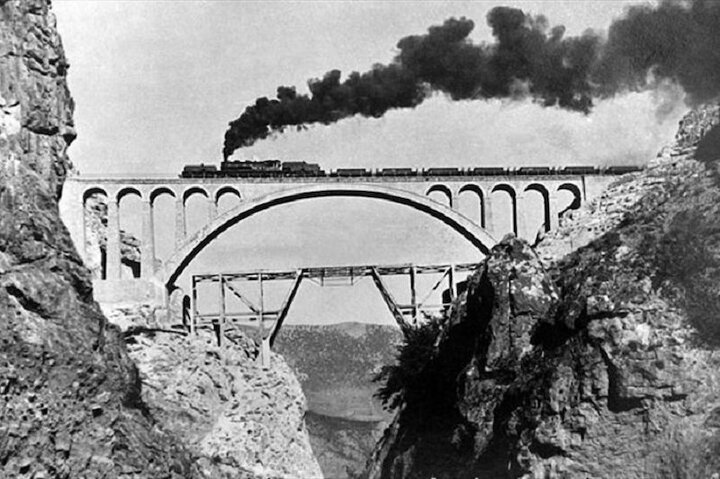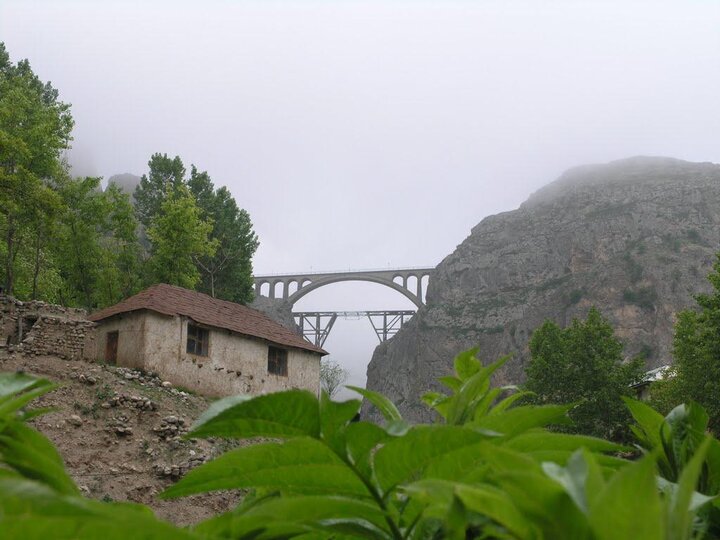Visit Veresk, a scenic masterpiece of the 20th century

TEHRAN – Massive arch bridges are engineering marvels that depict the ultimate intelligence, taste, and knowledge of an engineer and designer.
Veresk Bridge, which spans two cliffs in the Abbasabad area, connects the railways of Tehran to the Caspian Sea region. The arch bridge is one of the masterpieces of engineering of the 20th century.
Starting from Tehran, you will encounter semi-arid landscapes. As the train passes by the mountain slopes, you will eagerly anticipate spotting the distinctive greenery of the Caspian Hyrcanian forests, which are located in two entirely different climates on either side of the Alborz Mountains.

You can enjoy the pleasure of crossing a structure-free bridge at a height of 110 meters with a 66-meter-long arch by taking the train from Tehran to the cities of Gorgan or Sari and getting off at the Veresk Bridge!
There are plenty of reasons to visit the bridge, including the picturesque scenery along the Firoozkuh Road, a dream location in the middle of Mazandaran's natural beauty, and the city of Savadkuh, which is situated in Veresk town.
Arch bridges have a mechanism that transfers the bridge's weight and loads to their bases and a horizontal thrust that is constrained by the abutments on either side.

The mountains create these two sides in the case of the Veresk Bridge. Consideration of pillars in the middle of the bridge was not possible due to the considerable height from the bottom of the valley, but it may also be technically impossible to implement.
Veresk’s project execution began before World War II, in November 1934.
Veresk’s project commenced in 1934, well before World War II. It was inaugurated in 1936 during the reign of Reza Shah, who personally attended the inauguration ceremony in Savadkuh, his hometown.
It has been said that Shah asked foreign engineers and their families to stand under the bridge as the first train passed in order to reassure people who feared the bridge would collapse under the weight of the train.

The bridge is known as one of the masterpieces of the Danish engineering firm Kampsax (consisting of Danish, German, and Austrian engineers) serving the Trans-Iranian Railway network in northern Iran. The construction of this bridge included craftsmen of many nationalities, including Swiss and Italian people.
Near the bridge is a memorial structure built in memory of all the construction workers who lost their lives in the course of building the bridge and its nearby tunnels. The Chief Engineer, Austrian Walter Aigner, following his wishes, is buried in the local cemetery of Veresk.

Under the bridge is a tunnel through which trains pass after crossing the bridge and gradually dropping altitude before pulling into the train station.
Veresk Bridge is also referred to as the Pol-e Piroozi (The Bridge of Victory). This name's origins can be traced to World War II, when Iran played a role in assisting the Soviet Union, which was under German siege, by providing support. During World War II, the Allies sent supplies and troops to Russia via the rail route.
UNESCO designation
In 2021, the Trans-Iranian Railway, which reaches a length of 1394 km, was declared a UNESCO World Heritage site during the 44th session of the World Heritage Committee held in China’s Fuzhou.
It starts at a point north of Torkaman port located southeast of the Caspian Sea. After going through Sari and Qaem-Shahr, the railway enters the mountainous region of Alborz through Firoozkuh, which goes to Varamin and Tehran through numerous bridges and tunnels.
After crossing the flatlands of Qom and Arak, the Trans-Iranian Railway penetrates the Zagros highlands in Lorestan province and passes through numerous tunnels and bridges reaching Andimeshk situated on the low Kuzestan plain.
Finally extending to the vicinity of Dezful, Ahwaz, and its grand bridge on Karoon, the Trans-Iranian Railway is divided into two branches ending separately at Khoram-Shahr and Imam-Khomeini ports on the Persian Gulf.
AFM
